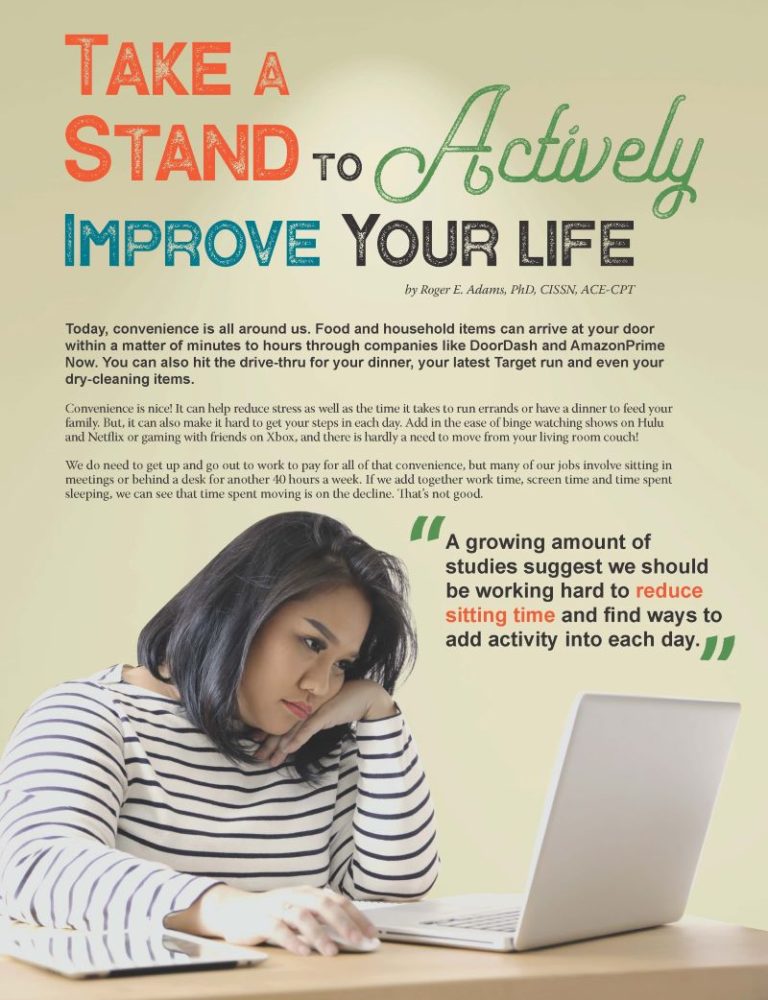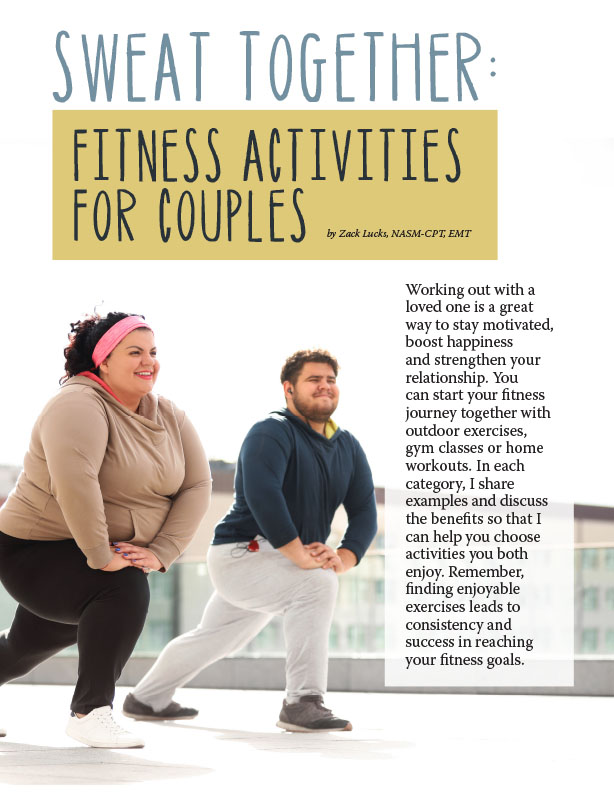Take a Stand to Actively Improve Your Life


by Roger E. Adams, PhD, CISSN, ACE-CPT
Fall 2019
Today, convenience is all around us. Food and household items can arrive at your door within a matter of minutes to hours through companies like DoorDash and AmazonPrime Now. You can also hit the drive-thru for your dinner, your latest Target run and even your dry-cleaning items.
Convenience is nice! It can help reduce stress as well as the time it takes to run errands or have a dinner to feed your family. But, it can also make it hard to get your steps in each day. Add in the ease of binge watching shows on Hulu and Netflix or gaming with friends on Xbox, and there is hardly a need to move from your living room couch!
We do need to get up and go out to work to pay for all of that convenience, but many of our jobs involve sitting in meetings or behind a desk for another 40 hours a week. If we add together work time, screen time and time spent sleeping, we can see that time spent moving is on the decline. That’s not good.
The Real Dangers of Being Sedentary
Simply put, excessive sitting is bad for our health.
Here is what happens when we sit too much:
- The activity in our muscles greatly decreases. Among other things, it can slow our metabolism.
- Our calorie-burning rate drops to about one calorie per minute. This is a third of what it would be if you walked.
- The insulin in our bodies becomes less effective even after a single day, and our risk of developing type 2 diabetes rises.
- Our ability to break down lipids and triglycerides drops. This causes our levels of good cholesterol (HDL) to fall.
Being Sedentary is Bad for Everyone
Prolonged amounts of uninterrupted sitting negatively impacts our overall health, even in relatively healthy adults. A growing number of studies suggest we should be working hard to reduce sitting time and find ways to add activity into each day.
Even healthy young adults show a decrease in their insulin’s ability to work after only 24 hours of sedentary time. While we know that exercise is NOT the perfect cure for wiping out the effects of sedentary behavior, movement throughout the day is the best option to keep these effects at bay. This does not mean you need to run a marathon, but you do have to move more. Movement matters!
A few Lessons Learned over Time
I’ve worked with clients for more than 20 years on increasing exercise and activity levels to improve health. Over time, I have found that the best way to make new habits is to find simple and easy ways to mix more activity into what you already do each day. We can’t all spend hours each day in the gym, but we can all find ways to move more.
Movement Matters
Movement is the key word here, so simply standing will not repair the effects of sitting. I encourage my clients to follow the 6/60 rule: walk for six minutes every 60 minutes during otherwise sedentary time. Research tells us that moving 10% more improves how glucose and insulin work in our bodies and can also lower our risk of heart disease and diabetes.
Another easy way to increase movement is by adding simple stretches into your day. Stretching throughout the day—both at work and at home—increases muscle activity and metabolism.
Additional benefits of stretching include:
- Improved circulation
- Reduced muscle tension
- Reduced anxiety, stress and fatigue
- Greater mental alertness
- Decreased risk of injury
- Improved mind and body connection
Any stretch that gets you out of your chair and activates your body will help.
A few simple stretches you can easily add to your day include:
- Stand and reach your arms as high overhead as possible, holding for 15-20 seconds.
- While standing behind your chair, hold the back of it and grab your foot or ankle and bring it to your backside. Hold this position for 15-20 seconds and repeat with your other leg.
- Try standing side bends to loosen up a tight lower back and boost the energy-burning compounds in your muscles.
- For a more aggressive stretch, do a few simple yoga poses such as upward and downward dogs.
These stretches will work wonders for your well-being and your health.
Don’t overthink it! Small, simple changes can create big results. Just look around for inspiration to sneak activity into your day:
- Take the stairs on short trips instead of the elevator.
- Park farther away and increase your step count.
- Walk over and talk with your co-workers.
- Use electronic reminders to increase your activity.
Once you have mastered the 6/60 rule and have added stretches and small changes into your daily routine, it may be time to add some equipment such as:
- A standing desk
- A treadmill or stationary bike desk
- Membership at your office gym or at a health club close to work or home
- A stability ball at your desk to improve muscle activation
Key Points to Remember
More than 60 years of research shows a link between physical activity and health. More recently, research has been done on the effects of sedentary behavior. Public health recommendations on limiting sedentary time are needed, as they account for almost 60% of an American’s typical day.
We must explore new and simple ways to reduce our sedentary behaviors, as the potential health benefits to be gained are substantial. Following the 6/60 rule at work and home, leading a workplace walking group, or walking your dog each evening will have you on the right path to better health and transform you into a moving picture of health!
About the Author:
Roger Adams, PhD, CISSN, ACE-CPT, is the owner of eatrightfitness – an evidence-based private practice focusing on weight-loss, disease prevention/management and sports performance nutrition, located in Spring, Texas. He has more than 19 years of experience working with clients to achieve better health and wellness. Dr. Adams is a certified personal fitness trainer by the American Council on Exercise (ACE) and is also a certified sports nutritionist by the International Society of Sports Nutrition (ISSN). He is also an active member in the Sports, Cardiovascular, and Wellness Nutrition, Nutrition Entrepreneurs and the Weight Management dietetic practice groups of the Academy of Nutrition and Dietetics. More information about Dr. Adams is available at EatRightFitness.com.
by Yelena Kibasova Spring 2024 The fitness world is evolving, with new trends and innovations that promise…
Read Articleby Zack Lucks, NASM-CPT, EMT Winter 2024 Working out with a loved one is a great way…
Read Articleby Nina Crowley, PhD, RD (with Inspiration from Shawn Cochran) Winter 2024 Dating, no matter your age,…
Read Article









